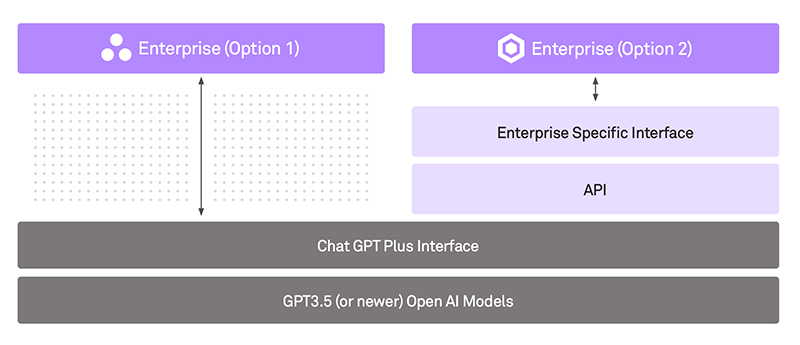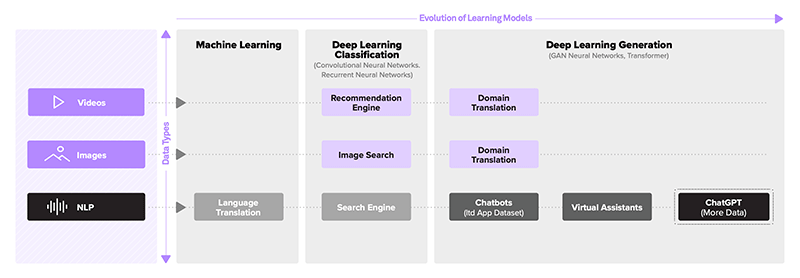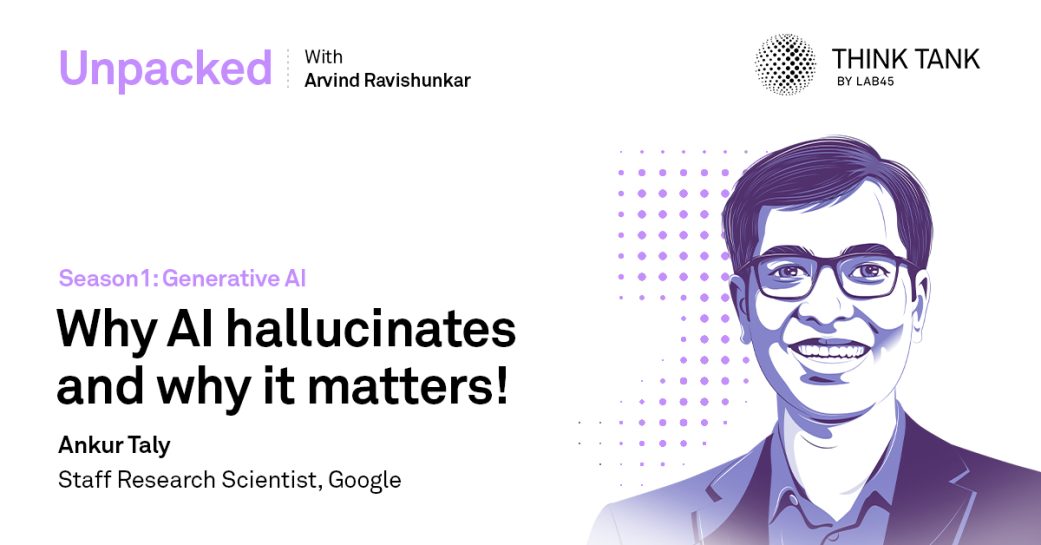Develop GenAI Strategy for your organization
Omid Bakhshandeh, AI Scientist
Watch Now
14:07 Minutes The average reading duration of this insightful report.

Discover the transformative impact of ChatGPT in the business world. Explore its potential in natural language processing, AI's role in enterprise strategy, and how leaders can leverage this technology for growth and innovation.
Explore a sneak peek of the full content
Short-term deployment strategies
In the immediate future, the emphasis is on implementing ChatGPT Plus and its API in selective functions within enterprises. This phase aims to measure the return on investment by integrating ChatGPT in various divisions, particularly in areas like code development and marketing. A key benefit of this approach is the potential enhancement of employee productivity through accelerated learning and execution, leveraging ChatGPT’s advanced capabilities.

Medium-term licensing and training
For a 6-month to 1-year outlook, the focus shifts to licensing GPT3.5 and tailoring it with company-specific intelligence. This move aims to bypass the limitations of the general-access SaaS model and utilize ChatGPT’s full potential. By customizing the AI with domain-specific data, enterprises can create distinctive products or services, thereby gaining a competitive edge.

Considerations and limitations
Key considerations include the confidentiality of data, the competency and adaptability of employees, and the initial costs and resources required for deployment. The hardware prerequisites, licensing costs, and additional expenses for model training are also crucial factors. The strategy involves a careful balance of immediate benefits against long-term investments, ensuring that the integration of ChatGPT aligns with the enterprise’s overall objectives and capabilities. Download Complete Research
The full model of GPT3 has 175B parameters. It translates to ~1TB of memory and requires a high-end GPU like NVDIA A100 & a highend CPU like Intel Xenon.
Evolution of machine learning and deep learning
The foundation of ChatGPT’s technology lies in the evolution of machine learning, a key subset of artificial intelligence where computers are trained to emulate human performance. Initially, machine learning powered simple applications like search and recommendation engines. Over time, it evolved into deep learning, which uses neural networks for more complex tasks. These neural networks, comprising units called artificial neurons, mimic the human brain’s functioning, processing data through interconnected nodes. This advancement is evident in modern applications ranging from chatbots to intelligent assistants.
Breakthrough with transformer models
A significant leap occurred in 2017 with Google’s introduction of transformer models. These models, central to ChatGPT’s technology, excel in processing entire sentences and generating text. They operate using an encoder-decoder mechanism and focus on the ‘attention’ principle, determining the relevance of each word in a context. OpenAI’s investment in these models led to the development of GPT (Generative Pre-trained Transformer) series, culminating in ChatGPT.
Factors Contributing to ChatGPT’s Success
This section highlights the technological advancements behind ChatGPT, illustrating its journey from basic machine learning applications to sophisticated natural language processing capabilities. Download Complete Research

Accuracy and misinformation
ChatGPT’s training on extensive internet data poses risks of inaccuracy and misinformation. It often lacks the latest updates and struggles to differentiate between fact and fiction, leading to potential misinformation, especially for non-experts.
Contextual understanding and bias
Another limitation is its inability to interpret emotions or hidden intentions, potentially resulting in inappropriate responses. Furthermore, biases in its training data can skew ChatGPT’s outputs, reflecting these inherent biases in its responses.
Operational costs and legal implications
Maintaining ChatGPT involves significant costs due to its complex system requiring regular updates. Additionally, legal challenges, such as copyright issues, can arise from its text generation capabilities.
ChatGPT has been trained on massive amounts of data from the internet, hence knows only the internet (which as humans we know can have inaccuracies and biases)
Environmental impact
The energy consumption for running ChatGPT is substantial, contributing to environmental concerns. The costs, both financial and environmental, of operating data centers and processing large datasets are significant, highlighting a need for more sustainable practices.
This section highlights ChatGPT’s main challenges: accuracy and bias issues, high operational costs, legal risks, and environmental impact. It emphasizes the need for addressing these concerns for its effective and responsible use. Download Complete Research
Credits
Lead Authors@lab45: Arvind Ravishunkar, Dinesh Chahlia, Nitin Narkhede, Noha El-Zehiry
Contributing Authors@lab45: Aishwarya Gupta, Anindito De

12:49 Minutes The average duration of a captivating reports.

Generative AI is forming a new economic ecosystem, reshaping the behaviour of key players in the IT industry, generating opportunities for super-scalers, and unveiling numerous niches for startups. The outlines of this new IT landscape are emerging, prompting a closer examination.
Generative AI has caused significant disruption, expanding its offerings and services well beyond traditional AI domains. This has led to an explosion of potential use cases for customers who aren't AI experts. Unlike before, customers no longer require a team of AI experts, curated data, or precisely measurable outcomes to adopt AI tool and gain immediate benefits. The interaction with GenAI is so seamless and intuitive that the onboarding for new customers is frictionless, eliminating barriers to adoption and facilitating rapid technology spread. The high variability in potential inputs and priming of generative models allows for a diverse range of applications impacting nearly every imaginable aspect of people activities. This is a foundation of a new era of Artificial Intelligence.
In this primer we leveraged our knowledge of 50+ GenAI-related and VC-backed startups to reconstruct the technological stack of the forming GenAI space.
Large tech companies are leveraging their existing technological and capital advantages to create the framework for the GenAI market landscape, which we are going to explore in this section.

While offering of the LLMs on the current scale and heavy focus on unstructured data are somewhat new, the other elements of the tech stack closely mirror those needed for any large computational modeling. Established companies in the field of traditional AI are at an advantage, as they can expand and repurpose preexisting software, infrastructure, and services. Download Complete Research
While large players are occupying a sizable portion of the GenAI tech stack, there remains more than enough room for GenAI startups to flourish. The landscape of AI and ML is continuously evolving, with new startups, technologies, and methodologies emerging regularly.

Bottom-right (AIOps): Here, startups may offer tools for easier adoption of LLMs, facilitating the initial process of customizing and implementing these models.
Ascending (Integration): Moving upwards represents the process of integrating LLMs into various applications and business operations. Startups could offer integration services, templates, or frameworks to streamline this, or build an entire end to end app for a selected market niche.
Moving left (Service platforms): As we move leftwards, the focus shifts from core LLM functionality to auxiliary services. This could range from platforms offering specialized training data, to marketplaces for LLM apps, to optimization tools. These firms may automate the need for certain experts.
This taxonomy can serve as a foundational overview for anyone looking to understand the current state of the LLM ecosystem. It’s also worth noting that the landscape of AI and ML is continuously evolving, with new startups, technologies, and methodologies emerging regularly. Let’s inspect each block in greater detail:
The future of the GenAI landscape is going to be defined by several processes:
While enhancing the users with great capabilities, the LLM-based service is neither a freebie, nor a cornucopia. Each implementation of LLMs carries its own advantages and downsides. In this section of the Appendix, we discuss what can and cannot be realistically expected from a GenAI model in each of the most popular use cases.
We start with primary properties of a pre-trained LLM model, underlying its strong sides and functionalities as well as build-in flaws. And we move to the current ways of augment LLM model to work around the flaws. Download Complete Research
The table of 78 startups we have based our analysis on is presented in this section.
The states of startups are set to the August of 2023.
Credits
Author@lab45: Rinat Sergeev

22:18 Minutes The average duration of a captivating reports.

This document navigates current airport challenges and presents advanced technology as the key to solutions. It offers profound insights into the future of global aviation, encompassing passenger management, sustainability, and technological integration.
The not-so-smart airports of the present face numerous challenges. Operations suffer from capacity issues, flight delays, and inefficiencies. Passengers endure long queues, baggage mishaps, and limited amenities. Root causes include aging infrastructure, rising air travel demands, and heightened expectations. Solutions must address sustainability, accessibility, cargo flow, baggage handling, workforce shortages, and facility limitations.
The global travel shift: Current industry and market trends reveal airports' adoption of new technology and operational strategies to tackle challenges. Emerging trends include enhanced passenger experiences, optimized capacity, safety measures, regulatory compliance, cargo logistics, and sustainability efforts. These initiatives reflect a trifecta of technological innovation, evolving customer expectations, and sustainability goals. Download Complete Research
Cutting-edge technology is revolutionizing airport operations, addressing core challenges. From AI-based gate allocation to IoT-enabled passenger flow monitoring, these innovations enhance efficiency, sustainability, and safety. Adoption levels vary, but promise a smarter future for airports.

The aviation sector faces sustainability challenges despite significant growth projections. Airports employ millions but also contribute to emissions, noise pollution, and land use issues. Innovative solutions are crucial to mitigate environmental impacts. New technologies offer hope, with initiatives focusing on energy efficiency, waste management, water conservation, carbon emissions reduction, sustainable construction, stakeholder engagement, and sustainable transportation. Adopting a "smart airport" mindset and leveraging advanced technologies are essential for sustainable development. Download Complete Research
Smart airport innovations offer incremental improvements, enhancing every aspect of the customer journey. From baggage tracking to disruption management, each innovation contributes to a vastly improved airport experience. These subtle enhancements, when integrated into a comprehensive system, create truly evolved airports. While current developments may seem marginal, they lay the groundwork for future radical transformations. Foundational changes in data and cloud technologies, along with private networks and digital twins, are revolutionizing airport operations. Innovations in transportation, such as urban air mobility and self-driving passenger vehicles, aim to streamline end-to-end customer transportation. With a growing focus on sustainability and continuous innovation, airports are poised for significant advancements in the coming years.
Future airports represent the culmination of incremental improvements, resulting in a transformative rethinking of airport design, operation, and customer experience. Redefining each step of the passenger journey from first principles can revolutionize airport travel. From travel to the airport to reaching the final destination, autonomous vehicles offer seamless transportation, reducing stress and travel time. Check-in and security procedures can be streamlined through biometrics and digital identity, eliminating the need for documents and minimizing delays. Optimized luggage handling and security checks ensure efficiency and convenience. Boarding processes can be expedited through automated sorting and biometric verification, enhancing overall travel experience. Additionally, autonomous vehicles can facilitate efficient flight transfers, reducing stress for passengers during layovers. With innovative technologies and redesign of airport processes, future airports promise a more seamless and enjoyable travel experience for passengers worldwide. Download Complete Research
Credits
Lead Authors@lab45: Ankit Pandey
This is your invitation to become an integral part of our Think Tank community. Co-create with us to bring diverse perspectives and enrich our pool of collective wisdom. Your insights could be the spark that ignites transformative conversations.
Learn More



Key Speakers
Thank you for subscribing!!!
